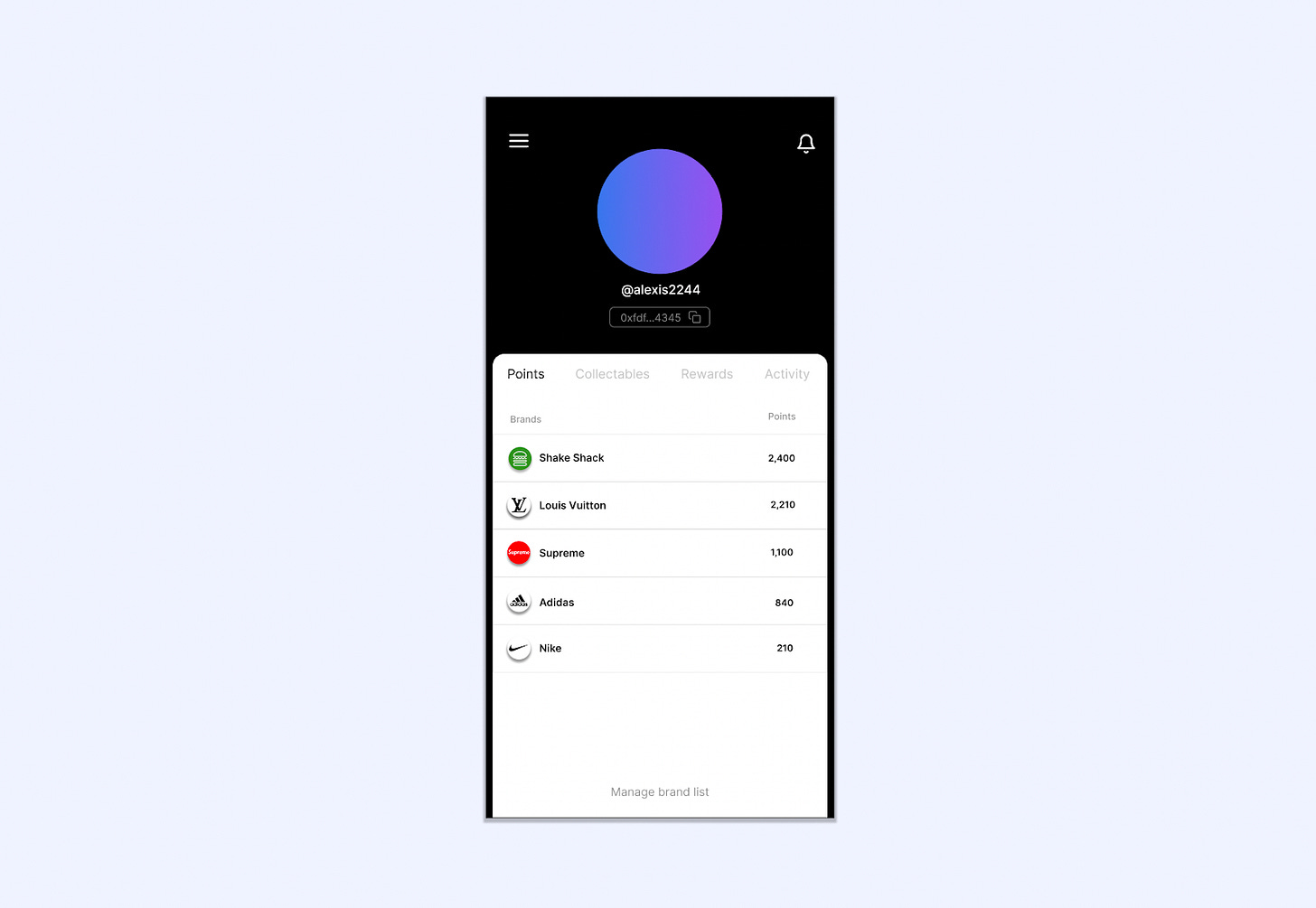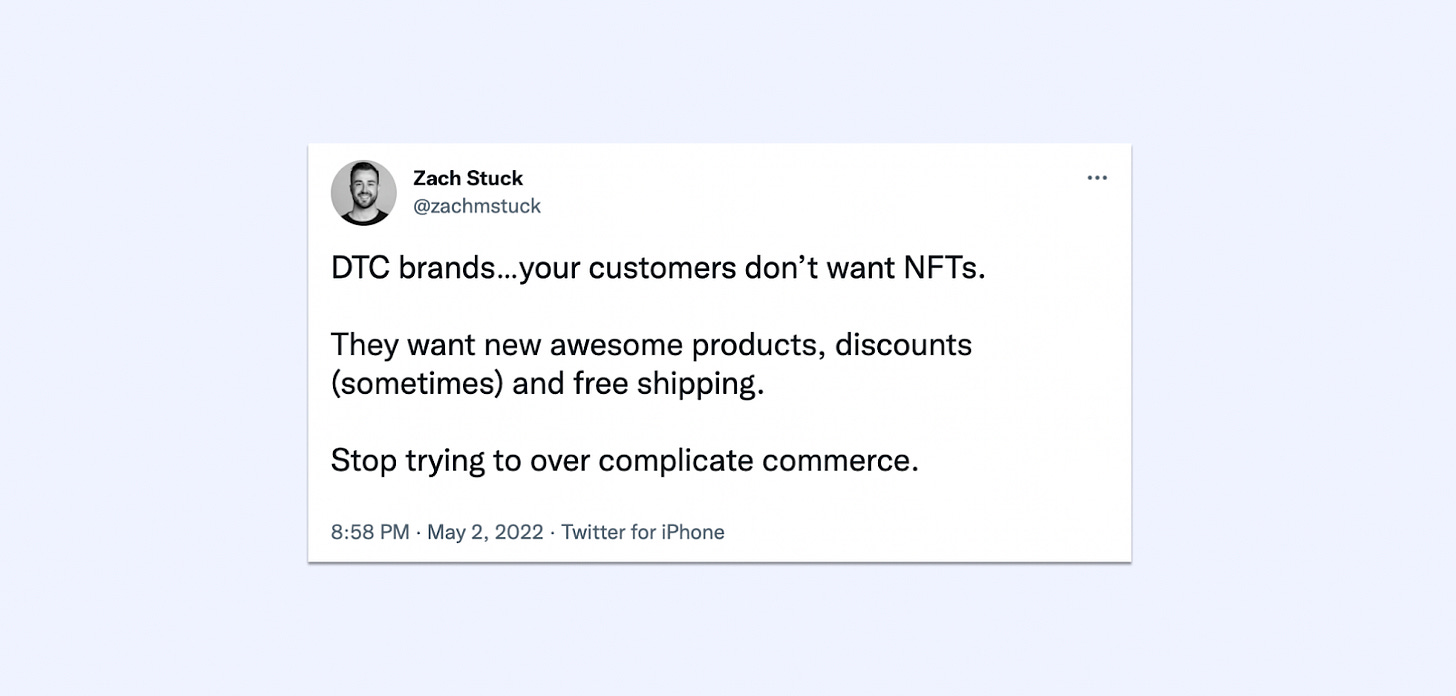Web3 commerce: Brand loyalty programs
Brand loyalty programs are boring. Can Web3 change that?
I originally published this via Interlace Ventures
Web3 Commerce x Loyalty
Since my first overview of Web3 x commerce, I’ve continued to study ways in which brands are experimenting with Web3. Customer loyalty stood out as an especially interesting topic.
Below are some thoughts on common loyalty platforms, the programs brands implement, and what they could look like if elements of them existed on-chain.
If you’re building or investing in this space, then let’s chat. My DMs are open on Twitter or shoot me an email at erik@interlacevc.com
Brands and retailers need loyal customers. In a time with rising CACs and intense competition in nearly every brand category, DTC and ecommerce-first brands are desperate to figure this out. Retaining customers is often more economical than acquiring new ones, with certain studies indicating that repeat customers will spend more than twice as much in months 24-30 of their relationship with a brand than they do in the first six months. This means that even a slight increase in customer retention can yield disproportionate increases in revenue.
To retain customers and incentivize them to spend more, brands deploy various loyalty programs. Whether such programs foster true customer loyalty (i.e. brand love), is disputable, and it may make more sense to refer to such programs as incentive programs. Either way, these programs do hold the potential to incentivize repeat purchases (increasing customer LTV) and perhaps superficial brand advocacy, both of which have measurable ROI. True customer loyalty is unique, requires clear customer benefits, and numerous interactions to create.
Points-based loyalty programs
One of the more popular loyalty strategies utilized by brands and retailers are points- and tier-based programs, often in unison. These programs essentially consist of a series of if-this-then-that formulas. For example, if the customer does X, then the brand rewards them with Y.
With if-this-then-that formulas, brands can reward customers for actions such as creating a user account, spending a certain amount of money within a fixed period of time, buying a specific product, creating content, the list goes on. In a tier-based system, the accumulation of points helps customers ascend to the next tier of membership, unlocking additional perks.
Three commonly used points-based platforms for brands of the type we’re discussing here are Yopto, LoyaltyLion, and Smile.io.
Customers rack up points and can later redeem them towards various perks such as free shipping, discounts, early access to future product lines, etc. The user’s account essentially behaves as a wallet, but can typically only be accessed and used via the brand in question.
Traditional points-based loyalty programs have plenty of pitfalls. In addition to being quite transactional, according to AdAge, the majority of points-based loyalty program participants do not know their points balance and a significant amount do not know the value of their points. It’s common for consumers to feel that it takes too long to accumulate a meaningful amount of points, causing participants to lose motivation. Rewards are often not perceived as valuable, and the process of earning points commonly requires excessive communication and messaging from the brand, attempting to nudge customers to perform a host of various tasks.
Although these types of engagement methods create economic and gamified incentives for customers to “come back”, in the majority of cases, it seems like a stretch to claim that they foster true loyalty. Instead, these systems simply tend to incentivize additional spending, which I believe is different.
Membership-based loyalty programs
As with points-based programs, the same question remains with membership-based programs: do these programs foster true customer loyalty, or are they simply another method to incentivize repeat purchases and increase customer LTV? Membership-based programs are on the rise and are used by brands/retailers such as Lululemon, Restoration Hardware, Italic (Italic Bold), and even Insomnia Cookies (Cookie Magic). Some companies’ business models rely entirely on memberships, such as Costco and Beauty Pie.
Membership-based programs have several benefits compared to points-based programs. For example, customers no longer need to perform transactional tasks (such as following the brand on social media) in order to accumulate points, many of which will eventually expire unused anyways.
Paying members will usually get immediate access to exclusive benefits upon joining; access to these benefits is no longer hidden behind confusing points schemes. Restoration Hardware offers its members 25% off all full-price orders, among other perks. Italic Bold, Italic’s paid membership, offers members free shipping on all orders and early access to new products. These are concrete, immediate benefits available to members from day one.
Committed, paying customers are more likely to spend more, and paid membership programs offer brands a source of recurring revenue. Amazon Prime has ~150M members paying anywhere from $11.5 to $15 per month… that’s at least $17B of incremental revenue.
Numerous Web3 teams are building similar loyalty platforms, but on-chain
This poses (at least) two questions:
Can putting elements of loyalty/incentive programs on-chain elevate the customer experience?
If yes, are we ready for this?
I believe the answer to the first question is both yes and no. Yes, I believe putting elements of loyalty programs on-chain can improve the customer experience and thereby enhance LTV. However, I don’t necessarily believe that this technology will provide any significant unlock towards fostering authentic loyalty, at least not in its current applications. Evoking feelings of trust and brand-love within a consumer still requires effort and multiple positive interactions. This technology, however, may provide new dimensions for such interactions to occur.
Below are a few use cases that various teams are tackling within the realm of Web3 and loyalty:
Assuming that points-based (incentive) programs are here to stay, and ignoring the question of whether they foster true loyalty or not, consumers will continue to struggle to keep track of their points across multiple brands. Today, a customer can only view their points balance by logging into their user account via the brand in question. As consumers join additional loyalty programs, keeping track of this siloed data creates a burden and is one of the reasons that so many points expire unused (and potential engagement is left on the table).
If points existed on-chain, they could theoretically be viewed through a single view, putting an end to the era of siloed loyalty points. This would make it easier for consumers to keep track of their balance (just as all ethereum-based tokens can be viewed through your ETH wallet) and for consumers to stay engaged.
As mentioned earlier, membership-based loyalty programs are on the rise. In simplified terms, what if the “key” providing a brand’s members with access to benefits, perks, events, etc. was in the form of an NFT issued by the brand? This would solve several pain-points and also pave the way for several interesting opportunities ranging from collaborations, to royalty revenue, etc.
Brands could launch tiered-membership programs of which there are a fixed number of slots in each tier. Imagine if a brand launched such a program and dropped 100 NFTs representing membership in the highest tier of their community. As a member of this tier, perhaps you get to vote on product decisions, branding decisions, etc. As the brand increases in popularity, the demand for access to this tier will likely also increase, enabling a secondary market for the keys into this sought-after tier of membership to exist. Given the transferability of NFTs, members could exchange them with one another, and could potentially stand to gain financially, and brands could capture royalties on each transfer as well.
Starbucks recently announced plans to release membership NFTs. “We plan to start with our first NFT collection, membership and community later this year, based on coffee art and storytelling. It will come with a host of unique experiences and benefits, worthy of a genesis NFT collection from Starbucks.”
Another scenario: imagine if two brands, say Supreme and Louis Vuitton, decide to collaborate on a new product, such as a co-branded hoodie, and they only want to make it available to each brands’ members of the highest tier. By token-gating access to the product page, they can restrict access such that only members who belong to a certain community (and hence have possession of a specific NFT) can actually buy the hoodie. This isn’t novel; brands have been doing this for a while (e.g. The Hundreds), but it serves as an example of how loyalty/incentive programs can elevate the customer experience by existing on-chain. Yes, a lot of this can be achieved, to some degree, by using passwords or secret discount codes, but it’s not the same thing, especially not in terms of the CX. There’s an allure in getting access to a discord server or a product page thanks to having the right assets in your wallet vs simply typing in a password.
As customers collect and accumulate on-chain assets, whether they’re membership NFTs, POAPs, or various collectables, their wallets begin to become a reflection of them and their behavior. This on-chain data tells a story about the consumer: what brands they interact with, what communities they are a part of, and so on. Brands can leverage this data in various ways, enabling them to offer further enhanced levels of personalized experiences and promotions.
Many of these use cases can be solved using different approaches that don’t necessarily require any elements existing on-chain. That said, these are mainly “version 1” iterations of what on-chain loyalty can look like. This space will evolve with new use cases, and we’re excited to see these developments.
Are we ready for this?
Ultimately, consumers will decide. However, we’re already beginning to see things unfold here. From emerging crypto-native brands to established Fortune 500 brands, the need to stay relevant has never been greater. Wallets will continue to become more user-friendly and will eventually allow a consumer to view their points and unlock exclusive experiences, all without necessarily understanding the nuances of what’s happening behind the scenes. Once this is true, then the rest of the world will probably be ready as well. In fact, putting brand loyalty programs on-chain can act as an incredible on-ramp for non-crypto native brands and consumers. Brand loyalty programs that are built on-chain can serve as an incentive for those still without a crypto wallet to get one and to begin interacting with this new frontier of the internet.
If you’re building or investing in this space, then let’s chat. DM me on Twitter or shoot me an email at erik@interlacevc.com
There are a few products in the space that I’d encourage you to view on Unbundled, including: Rare Circles, Novel, Passage Protocol, Hang NFT, etc.








Great stuff Erik!